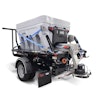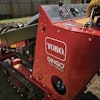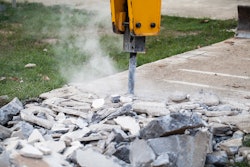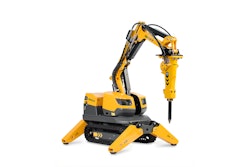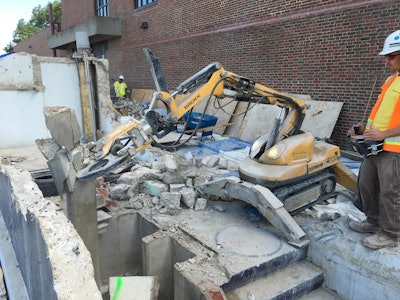
Information from this article was first published in Demolition Magazine and is being reused with permission from the National Demolition Association.
By Aaon Boerner
You can almost hear the cheers echo across the University of New Hampshire Wildcats Stadium even when it’s empty. The football field, track, seating and athletic facilities make for an exciting scene with the exception of one element: the announcer’s box. Standing above the stadium like a stout linebacker, the dark blue structure was considered an eyesore by the university. Dubbed the “blueberry” due to its color, the building had to go.
Demolition plans began after the construction of a new athletics facility across the field from the box and field house to which the box was attached. University officials wanted to remove the unsightly structure and install handicap seating in its place. They hired general contractor Charter Brothers Construction for the quick-turnaround job, seeking to have it finished in time for the fall football season.
In 2016, Charter Brothers chose to sub out the demolition portion of the project to EnviroVantage, a company with 30 years of experience in that industry. The subcontractor serves customers across the upper East Coast by offering environmental and specialty services including demolition, decontamination, disaster recovery, historical restoration, asbestos abatement and environmental cleanup. Scott Knightly, EnviroVantage owner and president, said one reason Charter Brothers selected them for the job was because of their Brokk 100 remote-controlled demolition machine.
 EnviroVantage paired its Brokk 100 with a concrete crushing attachment to minimize most of the noise and vibrations.
EnviroVantage paired its Brokk 100 with a concrete crushing attachment to minimize most of the noise and vibrations.
“We do a lot of work on campus already, so we’re familiar with the area. Plus, we have extensive experience — meaning we know how to get things done right,” Knightly says. “In this case, we also had a Brokk machine, which really was the best and most cost-effective way to do this project.”
Knightly knew demolishing the box would require extreme precision. The structure sat above locker rooms as well as aluminum stadium chairs that could be easily damaged by falling debris. The rest of the field house contained a swimming pool, basketball courts and other athletic features. EnviroVantage needed to complete the job without damaging the surrounding area or disturbing or endangering the students attending summer classes and camps in the building and on the field.
The announcer’s box wasn’t going down without a fight. The box was heavily reinforced, including 1-foot-thick concrete walls, floors and ceilings, all strengthened with 1-inch-diameter rebar. In addition, space inside was limited. The box’s three levels were each 500 square feet and only about 6 feet tall — just enough room for a person to sit in a chair in front of windows facing the field.
“I’ve never seen so much rebar in my life,” Knightly says. “I knew we would have to work hard and use our most productive techniques and tools to get this project done on time.”
 The B100’s 13-foot reach, coupled with the Darda CC340 concrete crusher’s 37 tons of power, allowed the operator to demolish the majority of the walls around the machine.
The B100’s 13-foot reach, coupled with the Darda CC340 concrete crusher’s 37 tons of power, allowed the operator to demolish the majority of the walls around the machine.
Innovative demolition planning
Knightly considered several demolition methods for the project, but the location of the box, the limited space around it and its composition made most traditional demolition methods nearly impossible. There wasn’t enough room for a crane or high-reach excavator to maneuver without damaging the track or field. EnviroVantage also couldn’t use large, handheld pneumatic tools because of the risk of vibrations causing microfracturing in the main structure. Knightly says even without the restrictions, the handheld tools wouldn’t have been powerful enough to break through the unforgiving concrete. Crews even tried using chemical expansive demolition agents, but the method was completely ineffective. The substance, which is supposed to expand and split the material once poured into a hole, didn’t work properly and released its pressure through the opening it was poured into. The concrete didn’t budge.
Knightly knew the most suitable option was to use the company’s Brokk 100 remote-controlled demolition machine to remove the structure. He knew pairing the machine with a concrete crushing attachment would minimize most of the noise and vibrations. The machine also delivers much more power than a worker with a handheld tool.
 Crews built ramps to allow the machine to drive up the almost vertical staircases.
Crews built ramps to allow the machine to drive up the almost vertical staircases.
Work started in June 2016, and the project’s biggest snag happened almost immediately, putting the deadline in jeopardy. Knightly originally planned to build scaffolding and drive the Brokk machine to the top of the structure and demolish from the top down. EnviroVantage learned just a week or two into the project that the concrete contractor required 30 days of curing time to complete the next step of the project following demolition. This change cut a month out of EnviroVantage’s initial three-month schedule and made the original plan impossible. The scaffolding would take two weeks to put up and another two weeks to take down. Knightly didn’t have that kind of extra time.
“We tried to arrange for the scaffolding to be put up faster, but it just wasn’t going to happen,” Knightly says. “We had to figure out something else. Fortunately for us, we had the versatility of the Brokk machine to work with.”
The plan changed from demolishing the box from the outside to breaking in and destroying the structure from the inside out. Knightly would use the Brokk 100’s precision, power and compact size to chew into the structure.
Breaking in to break out
The demolition required special safety measures. Because there was nothing above the structure to tie on to, workers core drilled into the concrete and installed channel angles to be used as tie-offs for crew members.
 To prevent debris damage, crews placed double layers of plywood and tires below the structure on all sides to cushion the blow from falling concrete.
To prevent debris damage, crews placed double layers of plywood and tires below the structure on all sides to cushion the blow from falling concrete.
To prevent debris damage, crews placed double layers of plywood and tires below the structure on all sides to cushion the blow from falling concrete. In addition, workers bolted chain link fencing in front of the box to catch debris. EnviroVantage placed a 35-foot conveyor near the project to deliver material over the field house’s railing, down a chute and into a dumpster 25 feet below.
Workers used small, handheld Hilti breakers to remove the roof after completing the abatement. The rooftop work was a slow-going, hot process. Temperatures reached as high as 120°F. Dealing with this meant starting work at 5:00 a.m., when the day was coolest, and working in 20-minute shifts when the air heated up.
Finally, with only 2.5 weeks until deadline, EnviroVantage moved in with the Brokk machine. This required widening the announcer box’s doorway and climbing steep staircases to get to the top level, just below the roof. Crews built ramps to allow the machine to drive up the almost vertical staircases. They maneuvered the Brokk 100’s three-part arm to help pull the 2,200-pound unit up at a 70-degree angle.
After it reached the third level of the box, EnviroVantage put the machine to work. The B100’s 13-foot reach, coupled with the Darda CC340 concrete crusher’s 37 tons of power, allowed the operator to demolish the majority of the walls around the machine. The contractor only used the machine’s breaker attachment occasionally to get at hard to-reach corners.
“We were working seven days a week at that point, so productivity was key,” Knightly says. “It was unbelievable how easily the Brokk demolished the concrete, especially since the other methods we tried barely scratched it.”
After demolition of the top floor was completed, crews moved the B100 down a level and demolished the ceiling and walls. They then moved the machine outside the structure and continued demolition until the box was level with the top of the stands. Workers used concrete saws to assist the machine along the way.
The machine’s power — and the fact that it didn’t need to take breaks from the heat or get fatigued — significantly boosted productivity. The operator stood in the shade and used the belt-mounted remote-control box to direct the machine. This meant the contractor was able to use the Brokk continuously for long periods of time. The remote-control operation of the unit kept workers away from safety hazards inherent in demolishing a ceiling and reduced the risk of hand and arm injuries related to constant exposure to vibrations.
 EnviroVantage finished its portion of the project after just 72 man-days of work and removed 105.8 cubic yards of concrete and rebar.
EnviroVantage finished its portion of the project after just 72 man-days of work and removed 105.8 cubic yards of concrete and rebar.
EnviroVantage finished its portion of the project in early August 2016, after just 72 man-days of work. In all, they removed 105.8 cubic yards of concrete and rebar. Then, the next contractor moved in to prepare the demolished area to be turned into handicap-accessible seating.
Knightly’s crew completed the job by deadline, despite losing a month of project time and needing to turn plans inside out. It’s a success he attributes to having the right tools and focus to reach the end zone.

